Adrian Collins's Blog, page 134
June 14, 2022
REVIEW: Prince of Thorns by Mark Lawrence
Prince of Thorns is simultaneously a grimdark fantasy, a post-apocalyptic dystopian thriller, and an epic revenge narrative told from the point of view of a first-rate sociopath. The sociopath in question is Honorous Jorg Ancrath, a brutally violent prince-child whose actions are not guided by any accepted sense of morality. As we learn more about the tragedies of Jorg’s childhood, we recognize how he became so twisted and understand his motivation for revenge.
 Jorg Ancrath has become one of the most iconic characters in grimdark fantasy. Mark Lawrence paints a very compelling portrait of a physically and emotionally scarred protagonist who is full of pride and consumed by rage. Telling the story from the first-person perspective of Jorg is the perfect way to get into his mind and understand the origin of his cruelty. Somehow, we also develop sympathy for Jorg throughout the course of the narrative. This is a testament to Mark Lawrence’s excellent characterization of Jorg in all of his complexity.
Jorg Ancrath has become one of the most iconic characters in grimdark fantasy. Mark Lawrence paints a very compelling portrait of a physically and emotionally scarred protagonist who is full of pride and consumed by rage. Telling the story from the first-person perspective of Jorg is the perfect way to get into his mind and understand the origin of his cruelty. Somehow, we also develop sympathy for Jorg throughout the course of the narrative. This is a testament to Mark Lawrence’s excellent characterization of Jorg in all of his complexity.
Some readers have been turned off by Jorg’s seemingly irredeemable penchant for violence. But this is nothing new in literature. One of the greatest novels of all time, Crime and Punishment by Fyodor Dostoevsky (1866), is also a first-person narrative told by a psychotic murderer who seeks to rationalize his acts of homicide. A more modern example is A Clockwork Orange, the 1962 classic by Anthony Burgess. Alex, the main character from A Clockwork Orange, served as inspiration for Mark Lawrence when he crafted Jorg, although Alex is even more viciously evil than Jorg, committing horrendous acts of violence for his own perverse amusement.
Jorg’s childhood is full of failed father figures. With young Jorg’s thirst for knowledge, Tutor Lundist could have filled the void left by Jorg’s own cruel father, King Olidan, but Lundist failed Jorg when he needed him most. As someone in a position of moral authority, Father Gomst also could have fostered a healthy father-son relationship with Jorg. However, his own moral backbone is not strong enough to compete with Jorg’s uncompromising personality. Father Gomst is a rather tragic figure: he is not a bad person, but he lacks the strength of character to live up to his own ideals and help Jorg grow to be a better person. One of the most amusing scenes from Prince of Thorns is when Father Gomst hears Jorg’s detailed confession, aghast with horror.
Jorg’s healthiest relationship is with the Nuban, whom he sets free from his father’s prison. Jorg recognizes the Nuban’s strong moral character, embodying the ideals of brotherhood that Jorg has tried to create with his band of Road Brothers. After being rejected by his father, only the Nuban is able to provide some sense of a moral compass for Jorg. Jorg seems to take these lessons to heart in the friendship that he later develops with Gorgoth, another outcast from society, and the way he readily adopts the young brothers Gog and Magog as his own.
A large part of what makes Jorg so compelling as a main character is the voice that Mark Lawrence has created for him. He is disturbed and illogical, but also darkly comic and even naïve in some respects. Jorg’s dark humor keeps the prose vibrant and the reader engaged throughout the novel, as we experience a combination of repugnance and wicked delight. All of this is balanced by Jorg’s deep-seated sadness, which reveals itself gradually throughout The Broken Empire trilogy.
The worldbuilding in Prince of Thorns is limited by Jorg’s own tunnel vision. Nevertheless, Mark Lawrence does a compelling job building layers of political intrigue in the neo-feudal land of the Broken Empire. Readers will be treated to more complete worldbuilding in the next two volumes of the trilogy, as well as in the companion Red Queen’s War trilogy.
Prince of Thorns is not a magic-heavy book, but it does include scenes of necromancy and dream- and fire-magic. The magic system is not explained in Prince of Thorns. Mark Lawrence leaves it to the reader to piece together the magic system across his five trilogies, which ends up being more science fiction than fantasy.
One of my favorite aspects of Prince of Thorns is the way Mark Lawrence blends grimdark fantasy with elements of post-apocalyptic dystopian sci-fi. The hints are there throughout the book. As a reader, the most surprising and rewarding aspect of this novel is when we discover the true nature of the world in which Jorg is living.
I’ve had the pleasure of reading Prince of Thorns several times. This is the special type of novel that gets better each time through, revealing its hidden layers and connections to the greater universe of Mark Lawrence’s writing. Jorg’s viciously dark humor also becomes more hilarious upon each reread. Most recently, I enjoyed reading the new Prince of Thorns Limited Edition, published by Grim Oak Press in commemoration of the tenth anniversary of this grimdark classic. The Limited Edition is a gorgeous bonded leather-bound volume with a sewn-in black satin bookmark, also featuring new full-color artwork by Jason Chan.
Prince of Thorns is one of the best and most influential books in grimdark fantasy, authored by one of the founding fathers of the genre. If you haven’t read Prince of Thorns yet, what are you waiting for? Come, brethren, and hear this Grimdark Gospel according to St. Mark.
5/5
Read Prince of Thorns by Mark LawrenceThe post REVIEW: Prince of Thorns by Mark Lawrence appeared first on Grimdark Magazine.
REVIEW: The Immortality Thief by Taran Hunt
The Immortality Thief is a beast of a book that managed to grip me in a matter of a few pages. In just so few words, Taran Hunt was able to lock me in for the rest of the story, her quick-witted characters and snarky dialogue piquing my interest on page one. The magic of this book lies within it’s mysteries, the story laced with a lingering sense of the unknown, and giving away too much would ruin the experience I want so desperately for other readers to have. I recommend going into this book blind, just as I did, not at all prepared for the unforgettable journey ahead.
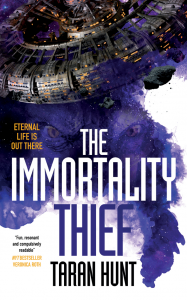 Without sharing too many secrets, The Immortality Thief was a cleverly executed space heist/mystery that I’ll soon be recommending to everyone that is willing to listen. The Immortality Thief follows Sean Wren, a passionate, snarky linguist and smuggler as he is given the task of salvaging important, secret data from an ancient ship orbiting a dying star. He and a few others are sent to this haunting, seemingly-abandoned wreckage and ordered to bring back data on the Philosopher’s Stone project. Yet he will soon learn that he and his small crew of criminals aren’t alone on this massive, derelict ship. Rife with the stuff of nightmares, this ship is extremely dangerous, and Sean and his crewmates are on a deadline as dangerous as they come. Not all is as it seems aboard this abandoned, haunting, nameless ship. This book wastes no time in tossing the reader in headfirst, and that’s partly why it works so well. You start off knowing absolutely nothing, which leaves you wanting—needing—to know absolutely everything. The strong worldbuilding and gritty character details are revealed alongside the immediate action and mystery, leaving behind a very tightly-written story.
Without sharing too many secrets, The Immortality Thief was a cleverly executed space heist/mystery that I’ll soon be recommending to everyone that is willing to listen. The Immortality Thief follows Sean Wren, a passionate, snarky linguist and smuggler as he is given the task of salvaging important, secret data from an ancient ship orbiting a dying star. He and a few others are sent to this haunting, seemingly-abandoned wreckage and ordered to bring back data on the Philosopher’s Stone project. Yet he will soon learn that he and his small crew of criminals aren’t alone on this massive, derelict ship. Rife with the stuff of nightmares, this ship is extremely dangerous, and Sean and his crewmates are on a deadline as dangerous as they come. Not all is as it seems aboard this abandoned, haunting, nameless ship. This book wastes no time in tossing the reader in headfirst, and that’s partly why it works so well. You start off knowing absolutely nothing, which leaves you wanting—needing—to know absolutely everything. The strong worldbuilding and gritty character details are revealed alongside the immediate action and mystery, leaving behind a very tightly-written story.
Sean Wren comes off the page almost immediately. The reader is able to understand and even predict our main characters decisions before we’ve even fully grasped the rules of his world. Taran Hunt clearly understands how to write strong, clear, three-dimensional characters and put her skills to work in The Immortality Thief. The first-person tone creates the strongest bond between Sean and the reader, but that doesn’t mean that any other of Hunt’s cast of characters are any less fascinating or well-developed. Mentioning any others by name would be, in my opinion, partially spoiling the intricate, captivating mystery The Immortality Thief lays out for the reader, but I promise that they’re as funny and badass as our favorite sarcastic linguist. Despite the well-developed and painfully human characters that drew me in instantly, the world building of The Immortality Thief stuck out to me the most.
Set in a world with only one free-standing government left, the rules and power structures in Sean’s situation are painfully clear to the reader. The scene is set tightly and quickly, leaving you to be sucked into the alluring mystery that clouds the ship Sean’s crew inhabits. Taran Hunt clearly displayed a strong set of world building skills in her debut novel. This well-built, dangerous galaxy provides the perfect playing ground to house some of the terrifying monsters Sean’s world holds. Without giving away too much about The Immortality Thief’s host of scary space monsters, each gruesome creature was more thrilling and frightening than the last. I’ll spare a slight detail—maybe those with a fear of bugs should skip over a few pages. The Immortality Thief took me by surprise, and left me wanting so much more from this debut author. Wonderfully written, simultaneously terrifying and hilarious, this book was enjoyable up until the very last page. 5 stars.
Read The Immortality Thief by Taran HuntThe post REVIEW: The Immortality Thief by Taran Hunt appeared first on Grimdark Magazine.
June 12, 2022
DISCUSSION: The GdM Team Plays Elden Ring
It’s a rare thing for a game to come along and live up to its own hype by not only being good but astounding, but for it to do it so utterly and completely that it razes the entire gaming landscape and leaves in its path an absurd slew of glowing reviews from practically every gaming site imaginable. To say nothing of the gaming community itself.
Elden Ring is a rarity. Anomalous in the way it attracts new players, some who’ve never played—or enjoyed—a “Soulsborne” game before. Though if you were do talk to the raving FromSoft fan community they’d tell you otherwise. That it’s the culmination of everything that has come before it. That it is the heir to a storied legacy of gamecraft and worldbuilding. It’s been some kind of impressive to see the chatter and activity surrounding Elden Ring starting long before the game even released to now, with its staggeringly large and inclusive community that continues to grow by the day. It has amassed a legion of fans who gleefully dive into the Lands Between to grow their own legends, to face outrageous ordeals, to engage in glorious battle.
There have been more superlative reviews of Elden Ring at the point of this writing than you could shake a branch of the Erdtree at. I don’t need to add another one to that pile, and that’s not what this is. This, instead, is a collection of experiences of players from their time exploring the Lands Between.
As for me? I’m a couple hundred hours into my adventures in the Lands Between and show no sign of slowing down. I’ll let the others go on about the gameplay and the richness of the world. The difficulty which may seem punitive until you have that epiphany that we all seem to have and suddenly you “git gud.” I won’t wax poetic about the amazing design and art and storytelling. I love all of that stuff, too, but at the end of the day I’m a simple guy. I have the same philosophy for video games as I do for movies, shows, books…they’ve got to be entertaining. I’ve got to enjoy myself to want to continue on, to go deeper, to see it through.
And Elden Ring, more than anything else, is a thoroughly enjoyable experience that rewards the player for pushing harder, going deeper, looking farther. It is, quite simply, fun as hell. So from those of us here at Grimdark Magazine, brave Tarnished, welcome to the Lands Between.
JAMES TIVENDALEAs I type this I am 106 hours into Elden Ring and currently at Level 163. I have a few loose ends I’d like to tie up before I face the game’s final boss, and I thought I’d reflect and jot down a few thoughts about my experience.
I really wanted to play this game. I loved the trailers, and that GRRM was involved. It’s the first game that I’ve bought on the day of release in years. Something about Elden Ring just clicked with me.
There have been so many “Wow” moments in my playthrough, and the whole experience has been excellent. Off the top of my head: luckily getting past Margit because I had a summon that gave him rot, so he slowly succumbed to death whilst I ran away from him. Getting transported to Sellia Crystal Tunnels in the early game and feeling truly terrified and underpowered, begging for a way out. Ranni and Fia’s entire storylines were great. Helping Rya and getting invited to Volcano Manor. Any time Iron Fist Alexander showed up. Farming runes at the group of sleeping alien-looking, kinda-cute enemies just before the battle with Mohg, Lord of Blood.
Feeling like I “got gud” at bosses like Astel, Commander Niall, and Maliketh, where, after 10-20 tries, I really felt like I got the patterns and timings down. There was one moment with Commander Niall where if I dodged him and hit Bloody Slash straight away, I sort of pirouetted away from his attack and landing mine expertly. It was an amazing feeling of overcoming something difficult by almost dancing with the enemies until the Great Enemy Felled text graced my screen. The fact that, apart from the final boss, Palisadiux, and one of the two Ancestor Spirits, I’ve managed to get all of the boss achievements: that’s something I’m pretty proud of.
This is the first time I’ve played a game and followed some streamers and/or the Twitter conversations. I really enjoyed watching AfroSenju’s videos on YouTube as we were mostly at the same parts in the game, so I found it fascinating to see how he tackled puzzles, bosses, what he missed, and also what he found that I couldn’t believe I didn’t see. The fan art coming out of the community is amazing, some of the time and effort people put into their art is incredible. Adding those with watching the legend of Let Me Solo Her grow, right up until their 1000th Melania kill, and still chuckling most days to Make Up A Tarnished Guy’s posts on Twitter.
Honestly, I’ve had a complete blast with my Elden Ring experience. I probably won’t start a NG+ for a while, but I’ve absolutely got my money’s worth from this fantastic game.
MATT BROADWAYLet me start by stating that I’ve only played one “Souls” game before. I bought Bloodborne when it first came out and played it for about forty-five minutes, promptly took the disk out, and put it on the shelf. It has been there ever since.
Elden Ring was a completely different experience for me. I am not done with the game yet. In fact, I got pretty far along in my first play through and realized I made some horrible mistakes. Or, what I thought were horrible mistakes. So I started over. Then I started over again. Then I quit that game and went back to my second game. So far, I’m probably about two thirds of the way through the game now. I also eventually discovered that I could have changed everything about my character eventually anyway without needing to start over, but I liked the name of my second character better.
I love the game. I love immersing myself in the world, I love the combat, and I love the quests. I could have done without the learning curve, but now I know I could have just looked all that stuff up on the Elden Ring Wiki or on YouTube. I like the discovery of the game even if it is frustrating. This game is the most frustrating game I’ve ever played, and I love it. Maybe I’m a glutton for punishment.
Do I recommend it? I wouldn’t do that to my worst enemy (if I had one). That said, it’s an awesome game. If that confuses you, maybe try it out, but don’t blame me. I warned you.
AARON JONESI’ve played an insane number of hours on consoles over the years. Thousands of hours in Final Fantasy. Hundreds in Elder Scrolls, Witcher, and Red Dead Redemption. I devour games and love every moment.
Elden Ring devoured me.
It turned me into a mess of a human crying out for save points and some kind of option to change the difficulty mode. I wanted a proper map. I wanted a clear path. I wanted direction. Then I had an enlightened moment. An epiphany. I think it was when I was killed for the millionth time by one of the early bosses (Godrick maybe, or was it Margit?). I was getting battered over and over again. But I didn’t quit. I sucked. I was getting my ass kicked but I still didn’t quit. And that moment when I actually defeated the bastard meant more to me than so many countless moments in my gaming history.
I love stories. Stories mean everything to me. Elden Ring has a story but it isn’t a clear one. Sure, there’s a lot of lore, and weird backstories to everything, but the main character doesn’t speak and there’s not a clear path laid out before you. Elden Ring doesn’t give a shit about that. It’s more about a mood. That beautiful, sinister mood that pervades the land and the unsettling feeling that permeates from the odd characters scattered around the Lands Between.
It’s that mood that pulls me back in and keeps me going. It feels alive. There’s such a freedom to the game and there isn’t anything like it. I’m level 100 and haven’t completed the game yet after 60 hours or so. I beat Radahn and that felt like a momentous achievement that I had to share with family and friends.
I no longer crave difficulty modes and the reassurance of save points. I’m all in on the Lands Between and as Tarnished as they come. There’s a cathartic beauty to the game that I’ve only rarely experienced before and that runs through pretty much every moment of my playthrough.
Elden Ring is a strange, stunning game and I’ve loved every moment.
MICHAEL BAKERI haven’t got much experience with FromSoftware games. I’ve played a bit of Sekiro before I picked up Elden Ring, but I’m the first to admit that the “Soulsborne” series never appealed to me very much. However, I was intrigued by the hype and attention that Elden Ring has rightly received. Would Elden Ring live up to its gigantic expectations? We’ve seen time and time again hype to be a double edged sword. If it’s not realized, the backlash is immense. We’ve seen that many times. Anthem, Fallout 76, No Man’s Sky, Cyberpunk 2077 and countless others have suffered various levels of failures from too much hype.
I only have around six hours in Elden Ring so far due to my only half-decent laptop and to lack of time, so I’m barely knocking on the door. I’m probably not qualified to review it yet, but I like what I’ve seen so far. The world design is fantastic and it feels like a revolution in open world design, similar to what Breath of the Wild achieved in 2017. I like what I’ve seen of the narrative, and I enjoy the combat. I wish it ran better overall and it seems to struggle with balance problems, but it lives up to the hype and deserves its critical acclaim. Time will tell whether it’s the right game for me.
CHRISTOPHER NAPIERElden Ring is the first FromSoftware game that I haven’t bounced off of within the first session. I’m not the type who’s willing to grind at a game for its own sake. Indeed, it’s the way that it managed to hook my ADHD-riddled attention despite repeatedly killing me in ways that would otherwise have earned a rage-quit long ago that’s impressive.
Elden Ring does this by looking beautiful, teasing with compelling story seeds and by rewarding exploration in so many ways: with views, with cool treasure and yes, often by being surprisingly murdered.
The lore of the Lands Between is tragic, deep and enigmatic, teased out when speaking to NPCs and if you want to look further, it’s there in the item descriptions and all over that beautiful world, from the plant life to the ruins and the races that inhabit it. I’ll not spoil anything, but it’s a tremendously layered, dark and morally ambiguous web of intersecting stories from the divine to the most base that I’d happily absorb myself in for a long time.
It’s not the difficulty that defines a game, but how much it makes you want to keep playing and overcome that difficulty. I think Elden Ring is a triumph that rewards tenacity, a game that doesn’t hold your hand but rewards you greatly once you’ve learned how to walk its ways.
The post DISCUSSION: The GdM Team Plays Elden Ring appeared first on Grimdark Magazine.
REVIEW: Kenshi
This is my debut to Grimdark Magazine! Michael here, and I’ve been brought in as the gaming guru. I might print that on a T-Shirt someday. My first article covers a fantastic indie game in Kenshi.
In the world of gaming, the indie world has grown considerably in scope and talent, especially over the last few years. The gap is slowly closing, and many of my favorite games ever made in recent years have been games developed by smaller studios. Usually when I talk to people about indie games, it goes like this:
Me: What’s your favorite indie game?
Them: I love games like Stardew Valley! Do you have any to recommend?
Me: You might like Kenshi.
Them: What’s Kenshi? I’ve never heard of it
That’s reasonable. Kenshi is a weird game to recommend to people. It was one of the first games approved on Steam’s Greenlight program, and one of the first Early Access titles as well to join the program. After several years of development, it rose from the ashes, fully releasing at the end of 2018. Since then, it’s grown even stronger, with a sequel in development. While it’s sold well and has had fantastic reviews overall, I rarely hear my circles talk about it. To many out there, Kenshi is a hidden gem. I’m here today to try and change that. With over 200 hours played in this game and counting, hopefully I know enough to try and convince you all to try this out.

It’s a strange game, and I can’t think of many rivals that do anything Kenshi does. It feels like the kind of twisted, dream game I would invent in my head when younger as the ideal game to exist in the world. Now, is Kenshi ideal for everyone? Of course not. All games have flaws, and Kenshi has plenty of those, but that doesn’t stop it being one of the most fascinating, open ended games on the market today.
I first bought Kenshi in 2014, back when there wasn’t a lot happening. Kenshi was made by a very small team, Lofi Games. They’ve come from humble beginnings, and for a while, Kenshi seemed like an experiment that wouldn’t quite make it. The indie market is booming now, but there’s still a stigma attached to the scene: every time an ambitious game comes out, there’s always daggers hanging over their heads. Will they succeed? Can I trust them after being burnt by this other game? It takes a lot to place trust into someone. I have the highest respect for anyone who gets into game development, especially when there’s so much competition.
Whenever people ask me what the ‘best’ indie games are on the market, I always think of a small selection of highly curated, S-tier titles. I have my own criteria for this, and it’s a project I’ve been working on for months, but Kenshi is part of this category.
First ImpressionsAt first glance, Kenshi looks like a psychotic, twisted experiment. The game looks rough, with a graphics engine which barely holds itself together under its many systems. There’s plenty of bugs, the optimization is rough and loading times are slow. There’s a steep learning curve involved and the player needs to be able to make their own narrative. It’s one of those games. There’s so many parts to Kenshi, so many types. It’s an exploration game. It’s a fighting game. It’s an open world RPG. It’s a squad-based sandbox. There are city building and survival elements. It shouldn’t work, and it nearly doesn’t, yet somehow Kenshi pulls it off. It doesn’t achieve everything, but there’s a brilliance to it.
Kenshi has a fairly simple premise. The world has been recently destroyed by mysterious means, and what remains is a shell of what it once was. There’s a massive, open world map full of lore, different biomes and factions, and the player is thrown right into the middle. There’s a few different starts a player can begin with, such as a solo start, a small group with building materials, a smuggler, or a trader. There’s plenty of modded starts available, but I’ll get to the modding potential soon. There’s an in-game set of tutorials that help early on, but the player is mostly left to their own devices.
Morning PainsThe start of Kenshi can be rough. There’s no starting quest or story to follow. There’s plenty of lore locked inside the world, but the player is left to their own creativity to work out what to do. For my many fellow writers out there, I find Kenshi to be one of the best games for storycrafting, because it forces me to create my own narrative. Even with the tutorials, the ancient interface makes the beginning difficult. Kenshi has plenty of dangers out there and survival mechanics. Many things in the game are fatal. Those beaky giraffes? Have fun while they bite your characters to death. Those sheep? Stay away from them. I’m not kidding. I’ve lost entire parties to a herd of rams before. Those cannibals? They will eat you. The Skin Bandits just want your skin, peeling it off with machines. See why Kenshi is a little grimdark? No wonder I picked this to review!
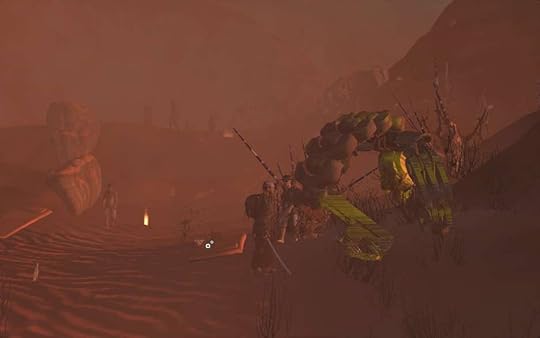
Kenshi requires patience, and not everyone will enjoy that. There’s plenty of mechanics which struggle to make themselves heard, and the game has incredibly long loading times due to its old and buggy engine. I recommend installing this on a solid state drive, and even then, loading times will be long. Be prepared for some frustrations on the technical side. I had some issues early on, but Kenshi is oozing with depth and charm.
At its heart, Kenshi describes itself as a squad-based sandbox game, but that’s putting it lightly. I don’t get how this game squeezes in so many different play-styles and game types, but it somehow works. It’s a miracle how ambitious it is. There’s settlement building, survival mechanics where the characters need food to live, form a mercenary company, farming and mining. While the tutorials are only basic, learning from trial and error is fantastic, and this comes with an excellent combat system. If the characters get smashed up in battle, they can be fixed up. Character stats get improved only through doing them; so if you want strong guys, they need to get stuck into fighting. Limbs will be cut off, arms will be lost. Fortunately, there’s a booming limb replacement business in the Kenshi world, so even these losses aren’t crippling.
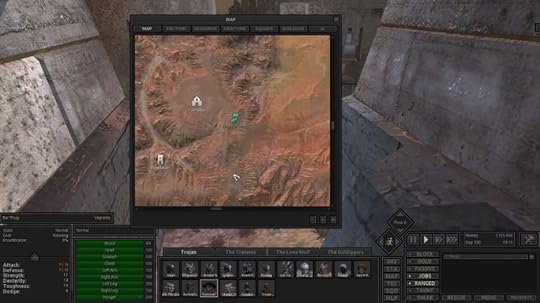
Kenshi is difficult, but it’s also surprisingly forgiving at the same time. The game is permadeath, but it’s a good idea to get stuck into battle. If characters get enslaved or imprisoned by different factions, that’s a blessing in disguise. Free healing and feeding! Some of these mechanics are easy to break, but the world allows that, so feel free to experiment.
There are several different factions in the game, but I’ll just cover the major ones. The Skeletons require no food to survive, but are despised by the Holy Nation who will attack them on sight and injuries cannot be healed normally. They require specialized kits which are expensive. The Holy Nation are zealots who hate everyone, require prayers every day, and will mess up everyone who disagrees with them. United Cities are all about money, money, money. Sheks are powerful warriors who demand food as payment and will kill anyone who smuggles drugs. The Hivers are fragile, insect-human people but will attack in great numbers. Making a settlement in anyone’s lands comes at a cost. The Holy Nation will come demanding tribute, Sheks demand food supplies, and United Cities require payments.
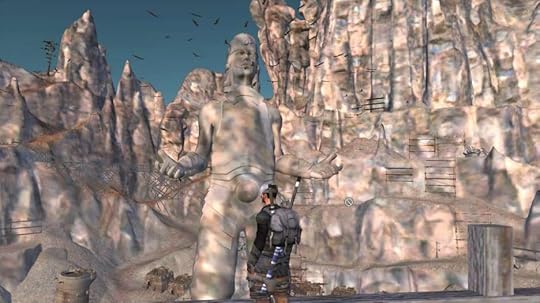
Onto settlement building, this is one of the key parts of Kenshi. I’d recommend building up a party and resources before attempting this, because it’s hard. There’s a large tech tree to unlock with research, which is expensive and time consuming, as well as plenty of things to build. Setting out and making towns is one of the coolest parts of the game, and there’s even some kind of persistent progression. In future playthroughs, there’s the option to keep all buildings in the world, so it’s possible to come across old cities you’ve created. There’s plenty of micromanagement trying to set up a good defense and holding off attacks: bandits and cannibal parties will come knocking frequently.
A Narrative MasterpieceIf hunkering down and making a settlement doesn’t sound appealing, don’t do that. Kenshi is so open ended that you can do pretty much whatever you like. I spent over seventy hours in a single playthrough just exploring the world and building a narrative. My most recent run told the story of two runaways: Khronin and lost robot Viro-V4, who formed an unlikely friendship and began their journey of redemption. Over many days of exploring the ruined world, they recruited more lost souls and built up their strength:
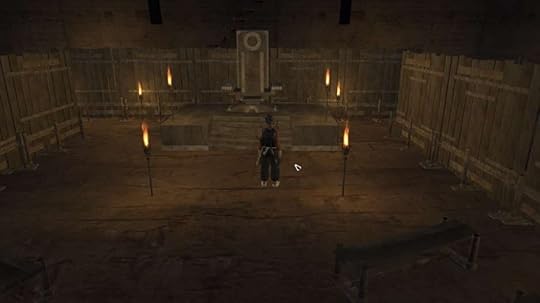
Khronin stands before the Shek leader’s throne. After several day’s travel, he and Viro-V4 have found some place to rest, even if it’s temporary.
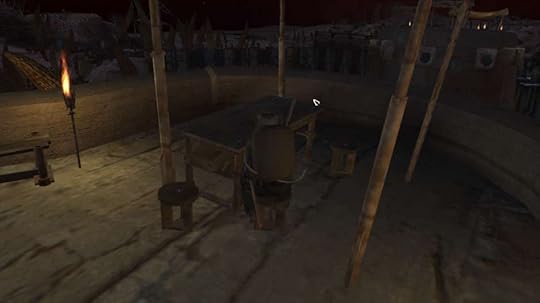
Viro-V4 spent more nights alone with his thoughts. War with the Holy Nation will be difficult, be he needs to do everything he can to survive.
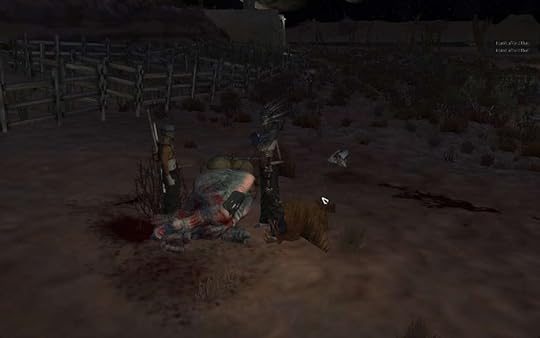
While hiding in the Shek lands, Khronin saved a Shek named Ruka from attack. The two agreed to join forces.
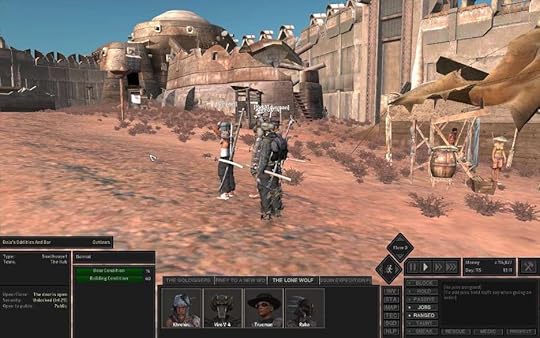
Over time, their army grew until they were strong enough to venture out to new lands. It’s time for justice! (Note the Dark UI. That’s a mod, and I highly recommend it!)
Final WordsKenshi has one of the most masterful open worlds I’ve ever experienced in a video game. There’s just so much variety in what to do that it’s almost overwhelming. I’ve rarely seen a game mesh with city-building, surviving, open world, combat and stealth mechanics so well together, even if it has to be brute forced at times.
It’s not well optimized, and the engine is buggy. It chugs harder than a train does on a normal UK weekday, the graphics are pretty ugly at times, and the game lacks direction. All of these are problems to contend with.
Despite these issues, I find Kenshi to be one of the most enjoyable and engrossing games I’ve played in years. Many of the game’s problems can be improved and fixed with the vibrant modding community, even if the modding tools themselves are quite limited. Kenshi has been so successful that Lofi Games are hard at work making a sequel. The sky’s the limit for these guys, and I’ll always be around to recommend Kenshi to anyone who wants a unique, fresh experience to try out.
Kenshi is available on Steam and GOG for around 25$/£22.99/23 Euros, but it frequently goes on sale.
https://store.steampowered.com/app/233860/Kenshi/
Score: 4 Stars.
The post REVIEW: Kenshi appeared first on Grimdark Magazine.
June 10, 2022
REVIEW: Death’s End by Cixin Liu
Your mind will be blown, flattened, and then collapsed to a zero-dimensional point in Death’s End, the epic finale of Cixin Liu’s hard sci-fi trilogy, The Remembrance of Earth’s Past.
Ken Liu is back as translator, bringing the same level of proficiency and eloquence to his translation of Death’s End as with the first volume of the trilogy, The Three-Body Problem. This is a welcome return to form after the rather awkwardly translated middle book, The Dark Forest.
 As in The Three-Body Problem, Death’s End features a strong female protagonist. The Three-Body Problem tells the story of Ye Wenjie, an ingenious physicist who is persecuted during the Cultural Revolution and becomes the first scientist to initiate contact with the Trisolaran alien civilization. Death’s End introduces us to Cheng Xin, a brilliant aerospace engineer who works as part of the Staircase Project to send a human into space to serve as a diplomat for meeting with the Trisolaran fleet. Having an inspirational female lead such as Cheng Xin is another welcome change from The Dark Forest, which focused on the rather uninspiring Luo Ji as its lead character.
As in The Three-Body Problem, Death’s End features a strong female protagonist. The Three-Body Problem tells the story of Ye Wenjie, an ingenious physicist who is persecuted during the Cultural Revolution and becomes the first scientist to initiate contact with the Trisolaran alien civilization. Death’s End introduces us to Cheng Xin, a brilliant aerospace engineer who works as part of the Staircase Project to send a human into space to serve as a diplomat for meeting with the Trisolaran fleet. Having an inspirational female lead such as Cheng Xin is another welcome change from The Dark Forest, which focused on the rather uninspiring Luo Ji as its lead character.
In The Dark Forest, Luo ultimately overcomes his unambitious nature to develop a Cold War-style system of mutually assured destruction, forming a fragile peace between the humans and Trisolarans. With his finger on the button of mass annihilation, Luo Ji becomes known as the Swordholder, a “chosen one”-type position that later passes on to Cheng Xin. However, the Trisolarans are not convinced that Cheng Xin would actually follow through on the threat of mutual destruction.
Death’s End is, by far, the most epic volume of The Remembrance of Earth’s Past trilogy, spanning hundreds of years across multiple eras of existence. As the plot progresses, the scope of Death’s End keeps expanding, from the world to the solar system, finally culminating in a grand inter-galactic drama where the fate of the entire universe is in jeopardy. The buildup of the story is highly satisfying and emotional, especially in the last third of the book.
Death’s End is full of imaginative and awe-inspiring ideas, most of which work effectively to drive the narrative forward. However, there are also a number of plot contrivances, such as the sudden appearance of a sophon-free room, enabling the humans to converse without fear of being intercepted by these intelligent Trisolaran-created subatomic particles. The ability to communicate without detection by the Trisolarans is a key part of the plot, but there is no attempt to explain how this sophon-free room came into existence.
Death’s End works best when it focuses on Cheng Xin and the great cast of supporting characters. I really enjoyed the relationship between Cheng and her former university classmate, Yun Tianming, as well as the friendship that blossoms between Cheng and her equally brilliant companion, the astronomer Ai AA. The cigar-smoking former CIA director, Thomas Wade, is a great foil for Cheng, embodying the corruption and individualism of Western capitalism. Another favorite character is Sophon, an android diplomat who is controlled by the sophon particles and serves as a communication link between the humans and Trisolarans.
While the character-focused text is highly engaging, the writing in Death’s End becomes less compelling in the many passages that are written in the dry style of history book excerpts. In these passages, Cixin Liu falls into the trap of telling, rather than showing, the reader about key plot events.
There are also three fairy tales which must be deciphered to understand three key secrets of the universe to aid in human survival. The idea of encoding scientific concepts into fairy tales is quite intriguing. However, I was rather annoyed by the self-congratulatory way that Cixin Liu presented these tales. At one point, Cixin Liu uses one of his characters as a mouthpiece to compliment his own writing: “I want to express my respect for the author. As fairy tales, these are very good.”
As a whole, The Remembrance of Earth’s Past is full of brilliant, mind-warping ideas from quantum mechanics, general relativity, string theory, and evolutionary biology. However, across the trilogy, Cixin Liu has established a somewhat uneven record of conveying these ideas to the reader. Cixin Liu’s writing works best when he combines the personal with the galactic, where the scientific advances lead to a better understanding of universal truths of what it means to be human, or more generally, what it means to be an intelligent being. Death’s End is, in many ways, a testament to our aspirations and accomplishments as human beings, and our ability to overcome the limitations of our finite intelligence.
4.5/5
Read Death’s End by Cixin LiuThe post REVIEW: Death’s End by Cixin Liu appeared first on Grimdark Magazine.
June 9, 2022
REVIEW: The Capsarius by Simon Turney
Many centuries ago the Roman Empire controlled vast swathes of the world. Its reach was broad, its might unquestionable, and the power of its legions was known—and feared—far and wide. Within the pages of The Capsarius, by Simon Turney, we find ourselves nested within the ranks of one of those legions. The Twenty-Second Deiotariana, a band of hardy and battle-hardened Galatians, freshly landed in the strange land of Aegyptus. But it’s not some mighty warrior or conquering general we found ourselves looking over the shoulder of—far from it. Turney fixes the perspective of the book on one Titus Cervianus, the titular capsarius (think of him like a field medic). Even among his colleagues, though, our Cervianus is a perculiar individual. While, like his brothers in arms, he does believe in the gods, he is a follower of Hippocrates and a self-described man of science. This gives him a unique, often times gratingly arrogant, perspective and sets him apart from his comrades who for much of the book harangue and harass him. Cervianus is something of a pariah, which allows The Capsarius to be much more than a meditation on ancient military tactics.
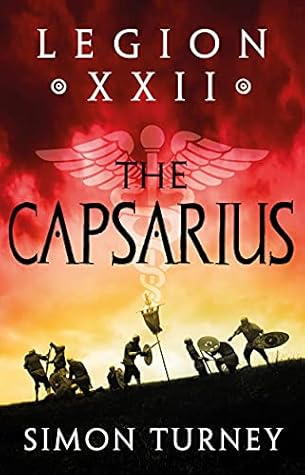 As a history geek, Turney gave me a lot to chew on in The Capsarius. The beginning of the book is kind of slow, not necessarily because of any kind of build up or exposition but because Turney has a remarkable sense of detail for the world the story inhabits, and the history of it. Cervianus, our protagonist, is a student of history himself and spends a lot of time ruminating on his surroundings, on the culture, and the history of ancient Aegyptus. It’s not terribly action packed—which isn’t to say The Capsarius shies away from action—but the focus for much of the book is on establishing the characters we’ll be spending our time with, fleshing out their surroundings, and building up what will become the central conflict and motivation. Which doesn’t mean nothing is going on, far from it. The Capsarius moves at a solid clip from beginning to end, with something always happening. Cervianus is quite the trouble magnet, a vortex that around which an incredible amount of intrigue and calamity circles.
As a history geek, Turney gave me a lot to chew on in The Capsarius. The beginning of the book is kind of slow, not necessarily because of any kind of build up or exposition but because Turney has a remarkable sense of detail for the world the story inhabits, and the history of it. Cervianus, our protagonist, is a student of history himself and spends a lot of time ruminating on his surroundings, on the culture, and the history of ancient Aegyptus. It’s not terribly action packed—which isn’t to say The Capsarius shies away from action—but the focus for much of the book is on establishing the characters we’ll be spending our time with, fleshing out their surroundings, and building up what will become the central conflict and motivation. Which doesn’t mean nothing is going on, far from it. The Capsarius moves at a solid clip from beginning to end, with something always happening. Cervianus is quite the trouble magnet, a vortex that around which an incredible amount of intrigue and calamity circles.
When The Capsarius finally does hit its stride and get to the real meat of the story, when the action kicks off, it doesn’t let up for a second. We join the Twenty-Second Legion on a frenetic, brutal campaign through the desert filled with the horror of war and steeped in blood and violence. Turney has a gift for orchestrating conflict, crafting relentless, exhilarating scenes that will leave you breathless. The Capsarius is full of action, thrills, shocking violence, and characters that you will learn to love and root for along with characters you will absolutely love to hate. If there’s any downfall at all to The Capsarius, it’s that it is obviously the opening salvo in a new series and will leave you chomping at the bit for the next book which—as far as I’m concerned—cannot come soon enough. Turney has turned out an awesome tale in The Capsarius, earning a bloody four out of five stars.
Read The Capsarius by Simon TurneyThe post REVIEW: The Capsarius by Simon Turney appeared first on Grimdark Magazine.
June 8, 2022
REVIEW: Cold as Hell by Rhett C. Bruno
COLD AS HELL by Rhett Bruno is the sequel to DEAD ACRE, an audiobook original that I enjoyed. Cold as Hell, by contrast, is a story that is available in both Kindle as well as Audible forms. Of the two, I strongly recommend the audiobook version due to the fact it is narrated by Jaime Castle (AKA Arthur Morgan from Red Dead Redemption 2). It’s not that the book isn’t good without Jaime’s narration, but he does such a fantastic job and is such a familiar sounding voice to fans of said game that it really pumps up the experience.
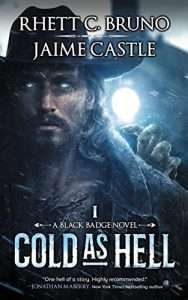 The premise is James Crowley is a former bandit who got himself killed doing one good thing after a lifetime of evil deeds. This results in him being recruited by the forces of Heaven to serve as their bounty hunter, fighting against the various monsters as well as supernatural evils afflicting the Earth. Honestly, he has a bum deal since if he succeeds then he will have his soul obliterated versus being consigned to Hell. I’m not sure if this is maltheism or a plot point, though, since Crowley’s angelic overseer, Shar, doesn’t seem to be very God-ly herself.
The premise is James Crowley is a former bandit who got himself killed doing one good thing after a lifetime of evil deeds. This results in him being recruited by the forces of Heaven to serve as their bounty hunter, fighting against the various monsters as well as supernatural evils afflicting the Earth. Honestly, he has a bum deal since if he succeeds then he will have his soul obliterated versus being consigned to Hell. I’m not sure if this is maltheism or a plot point, though, since Crowley’s angelic overseer, Shar, doesn’t seem to be very God-ly herself.
Anyway, Crowley is sent by his superiors to investigate a strange bank robbery that undoubtedly involves the supernatural. What follows is a complicated mystery involving silver mining, Native American rights, werewolves, demons, and the possibility there’s more out there than the God of Abraham and demons. Really, it’s a surprisingly twisted and labyrinthine plot given the relatively simple and straightforward one of Dead Acre.
Speaking of Dead Acre, I’d strongly recommend readers start with it instead of reading this as their first exposure to the Black Badge series. A major character first appears in that audiobook and her appearance here loses a lot of its dramatic impact without the setup done that novel. It’s also just a really good book by itself and well worth the Audible credit to purchase. If you don’t like audiobooks or want to read this as your start to the series, I’m sorry to say the story will be diminished.
As Weird Westerns go, Rhett Bruno did an excellent job setting up this environment and it is probably the best story we’d ever get for a Deadlands adaptation despite being its own original story. Certainly, it also works in the same vein as Red Dead Redemption: Undead Nightmare as well. Crowley is a revenant that looks human but is very much dead. He is incapable of enjoying the, uh, finer things in life and that adds to the sense he’s a man suffering from a dreadful curse.
The action is excellent in the book, and we have a wide variety of monsters for our antihero to dispatch. If I have one complaint, it is naming one of the demons after Coyote. Coyote is a benevolent figure in Navajo mythology (for the most part) and using him is something that feels in poor taste given much of the rest of the book is about condemning the treatment of Native Americans in the Wild West. Much like Disney’s The Lone Ranger, except not sucking, this book tackles a few Wild West myths.
In conclusion, I really recommend Cold as Hell. I was a big fan of Rhett Bruno’s The Roach, and this takes a similar deconstructionalist tone to many Wild West tropes that The Roach took to superheroes while making use of others.
Read Cold as Hell by Rhett C. BrunoThe post REVIEW: Cold as Hell by Rhett C. Bruno appeared first on Grimdark Magazine.
June 7, 2022
REVIEW: The Book of Gothel by Mary McMyne
The Book of Gothel by Mary McMyne is a compulsively readable historical fantasy inspired by the fairy tale of Rapunzel. Set in the Holy Roman Empire in the twelfth century, this tells the story of Haelwise, daughter of Hedda, and how she became the evil witch of stories manifold, taking baby Rapunzel from her mother and imprisoning her in the tower of Gothel. While a fantasy novel, The Book of Gothel is grounded in history, and contains recognisable characters, namely Emperor Frederick and Hildegard von Bingen. As someone who spent years studying the high medieval period, this made my heart sing, having a book rooted in the period and showing such care in regards to research – while clearly not a historical text, it captured the spirit of the era well.
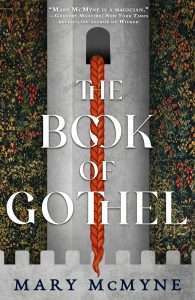 I really enjoyed reading this story from the perspective of the villain – Haelwise is aware of her perceived role, and it is not wholly unjustified in all aspects. She is selfish at times, which makes a woman stand out in the society of the time, she is determined and ferociously stubborn. She has no qualms to lie when needed to protect those she cares about or to reach her own goals. But, this witch of Gothel is not evil. She is a complex figure, a complicated woman. She is doing her best, and that makes her interesting.
I really enjoyed reading this story from the perspective of the villain – Haelwise is aware of her perceived role, and it is not wholly unjustified in all aspects. She is selfish at times, which makes a woman stand out in the society of the time, she is determined and ferociously stubborn. She has no qualms to lie when needed to protect those she cares about or to reach her own goals. But, this witch of Gothel is not evil. She is a complex figure, a complicated woman. She is doing her best, and that makes her interesting.
It is a story with a clear villain, but also many minor villains. Most characters are somewhere on the morally gray spectrum, and Mary McMyne does well in showing how personal aims drive their actions. I really enjoyed how the book went into tropes of storytelling, of perspective, of how tales change through the telling. History is famously written by the victors, but I’d like to propose a more nuanced take. History is written for a purpose, history is a tool wielded with surgical precision, whether by victors or those who have something to lose. This is true of chronicles as it is for stories within stories such as this one.
As a whole, I absolutely loved The Book of Gothel. It combines everything I tend to love about stories in a breathtaking manner and is very hard to put down. It is a feminist take on an old fairy tale trope, it is a historical fantasy and it has wonderfully murky morals. While there are romantic elements to the story, those are not at the forefront and Haelwise’s character development is centred. It is a book I highly recommend and I see myself coming back to again and again.
Read The Book of Gothel by Mary McMyneThe post REVIEW: The Book of Gothel by Mary McMyne appeared first on Grimdark Magazine.
REVIEW: The Rush #6 By Simon Spurrier and Nathan Gooden
Obsession. We all have some familiarity with it. We’ve all experienced it. We all know what it is to have a death grip on a thing, for it to consume our thoughts. It can be overwhelming, pervasive, all-consuming. In The Rush, or, This Hungry Earth Reddens Under Snowclad Hills, obsession is the driving force of the story. Within its pages, from the first issue—which seems so far away ago now—to the cathartic, explosive finale, we see how far people will go in the name of their obsessions.
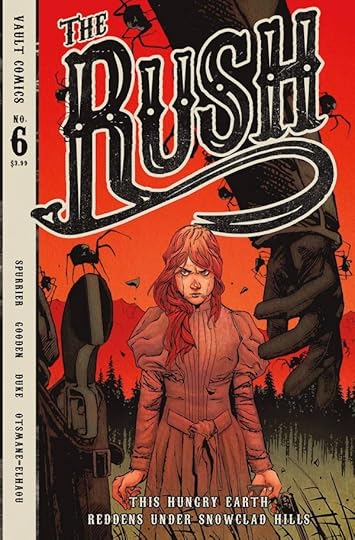 Gold. Power. Love. Revenge. Family. Obsession is the root, the heart of The Rush, the axis around which everything spins and whirls in a vibrant, violent dance. It’s been a glorious, gory adventure, one which I’m frankly sad to see end and part with—but it ends well. And that’s an accomplishment. Not many stories can stick the landing, live up to their own hype, but The Rush manages it in spades. In the final chapter our heroine Nettie sees even more horror, sees even more depravity, tastes even more of the brittle, blistering madness that so many others in the northern wastes had succumbed to. Nettie, though, is a woman made of iron. At the end of things, as the pages of The Rush wind down, she faces her tribulations and clenches the hand fate has dealt her in a deathgrip. Monsters and madmen will not detract her from her vengeance, will not dissuade her from the vindication of her obsession. A mother’s obsession. It’s remarkable. It sings. In the sixth and final issue, The Rush is, quite frankly, brilliant.
Gold. Power. Love. Revenge. Family. Obsession is the root, the heart of The Rush, the axis around which everything spins and whirls in a vibrant, violent dance. It’s been a glorious, gory adventure, one which I’m frankly sad to see end and part with—but it ends well. And that’s an accomplishment. Not many stories can stick the landing, live up to their own hype, but The Rush manages it in spades. In the final chapter our heroine Nettie sees even more horror, sees even more depravity, tastes even more of the brittle, blistering madness that so many others in the northern wastes had succumbed to. Nettie, though, is a woman made of iron. At the end of things, as the pages of The Rush wind down, she faces her tribulations and clenches the hand fate has dealt her in a deathgrip. Monsters and madmen will not detract her from her vengeance, will not dissuade her from the vindication of her obsession. A mother’s obsession. It’s remarkable. It sings. In the sixth and final issue, The Rush is, quite frankly, brilliant.
The whole team behind the book should be commended in their accomplishment. From Simon Spurrier, weaving together the glittering, blood-soaked tale of The Rush, proving yet again that he’s a force to be reckoned with in the pantheon of comic writers. To the outrageously talented Nathan Gooden lushly illustrating every page, conducting every scene, making every face and action flow. And Addison Duke’s colors. Textures. So vibrant, so inspired. Delving sometimes into the feverish and hallucinatory, combining with Gooden’s art to create a gorgeous sensory experience. And, of course, hats off to Hassan Otsmane-Elhaou for the classy, creative, lovely lettering. It’s rare that a team combines so effectively to create something so amazing.
What more can I say that I haven’t already said? I’m sad to see The Rush end. It’s been one of my favorite things coming out on the stands now for months. Something I look forward to, and now it’s over. But I’m glad, thankful even, for having experienced it, and I cannot wait to see what the talents who created it go on to do next. Five stars? All the stars.
Read The Rush #6 By Simon Spurrier and Nathan GoodenThe post REVIEW: The Rush #6 By Simon Spurrier and Nathan Gooden appeared first on Grimdark Magazine.
June 5, 2022
REVIEW: Screams from the Dark edited by Ellen Datlow
In Screams from the Dark, Ellen Datlow brings together twenty-nine of today’s boldest voices in horror to create an unflinching symphony of darkness that will haunt you long after you close the back cover. These all-original tales include stories by such established luminaries as National Book Award winner Joyce Carol Oates and two-time World Fantasy Award winner Caitlín R. Kiernan, as well as a phalanx of rising superstars in horror from across the globe.
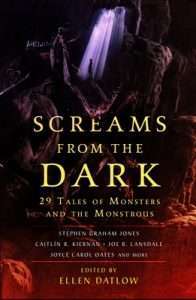 The short stories of Screams from the Dark are populated by monsters in all their twisted forms. Datlow begins Screams from the Dark with an enlightening introduction on the complicated etymology of the word “monster.” Originally interpreted as a warning for humanity about the omnipotence of God, the concept of a monster has evolved to embody anything that is grotesquely inhuman, bent on destruction and evil. Monsters are often portrayed as physically hideous or psychologically terrifying, a distorted version of ourselves. Physical manifestations of the monstrous embody the opposite of the humane, but also reveal our inner evil, helping us to understand the nature of humanity itself.
The short stories of Screams from the Dark are populated by monsters in all their twisted forms. Datlow begins Screams from the Dark with an enlightening introduction on the complicated etymology of the word “monster.” Originally interpreted as a warning for humanity about the omnipotence of God, the concept of a monster has evolved to embody anything that is grotesquely inhuman, bent on destruction and evil. Monsters are often portrayed as physically hideous or psychologically terrifying, a distorted version of ourselves. Physical manifestations of the monstrous embody the opposite of the humane, but also reveal our inner evil, helping us to understand the nature of humanity itself.
Screams from the Dark features all the standard monsters of horror literature, including vampires, skeletons, ghosts, witches, giants, sea monsters, werewolves, Bigfoot, and the requisite Cthulhu-inspired tentacle monster, here terrorizing an amusement park in “The Midway” by Fran Wide. There is also a fresh take on the Tasmanian devil, courtesy of Glen Hirshberg’s excellent story, “Devil.” More outlandish monsters appear in “The Virgin Jimmy Peck” by Daryl Gregory, where a cultist has been surgically implanted with a monster baby, and in “Sweet Potato” by Joe R. Lansdale, where a vegetable-scented succubus visits a lonely retired man who takes his newfound gardening hobby a bit too seriously.
Beyond the classic villains of horror, Screams from the Dark addresses monstrosities arising from ecological disaster in “Strandling” by Caitlín R. Kiernan and in “The Smell of Waiting” by Kaaron Warren. In a nod to current events, the impact of the COVID-19 pandemic is addressed in “Wet Red Grin” by Gemma Files, which details nursing home patients subjected to reddening of the bones, and “The Atrocity Exhibitionists” by Brian Hodge, centering on a rock star seeking pandemic-era social media fame through extreme self-harm.
My favorite story in this collection is “Crick Crack Rattle Tap” by A.C. Wise, which features a young single mother battling postpartum depression. She oscillates between wanting to be a good mother and feeling resentment toward her infant baby. The mother recites an improvised rhyme, accidentally summoning the demonic Rattle Tap, asking him to take her baby away. A.C. Wise does an outstanding job getting into the mind of a sleep-deprived mother losing control of her own mental processes in this twisted, nightmarish fairy tale, where Rattle Tap becomes an external manifestation of the beast within us all.
Another standout that brings our inner monsters to the forefront is “The Last Drop” by Carole Johnstone, which describes a 19th century murder trial. Although the story itself is fictional, all of the testimony is taken from the transcripts of real court cases published in the Dumfries and Galloway Standard and the Wigtownshire Free Press in 1862.
While I am emphasizing the heavier stories, there is also a lot of fun within the pages of Screams from the Dark. The opening story, “You Have What I Need” by Ian Rogers, features a woman who checks herself into the emergency room at Chicago Hopeless hospital after being bitten by a vampire, possibly infected with the vampire virus. During her quarantine period, the emergency room is viciously attacked by three vampires from the streets. Another dark delight is Richard Kadrey’s “What is Love but the Quiet Moments After Dinner?” which explores two lovers whose violent passions culminate in some casual…um…cannibalism.
The twenty-nine stories in Screams from the Dark masterfully examine the nature of monsters and monstrosities, both tangible and abstract. Ellen Datlow’s extensive experience as a short story editor shines throughout the entirety of this volume. Screams from the Dark earns my highest recommendation, ranking among the best compilation of short stories that I’ve read in any genre.
5/5
Read Screams from the Dark edited by Ellen DatlowThe post REVIEW: Screams from the Dark edited by Ellen Datlow appeared first on Grimdark Magazine.



